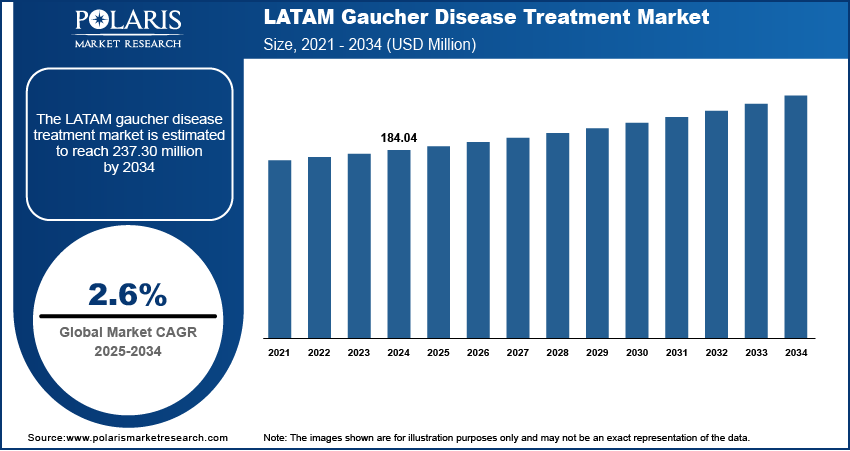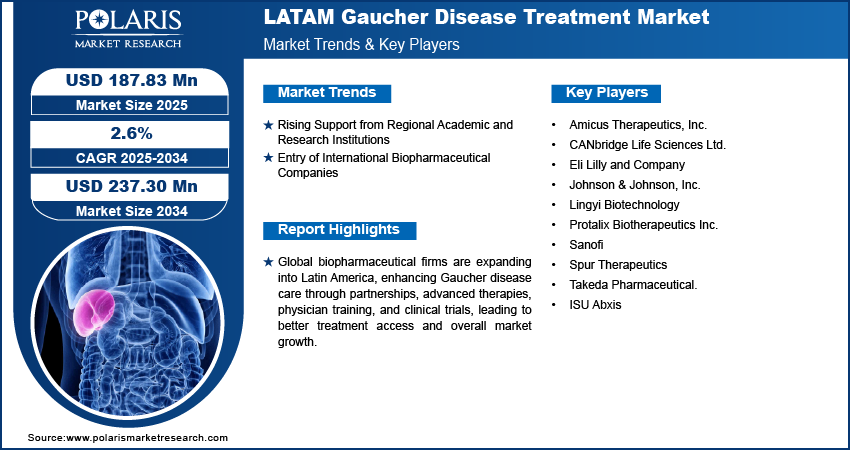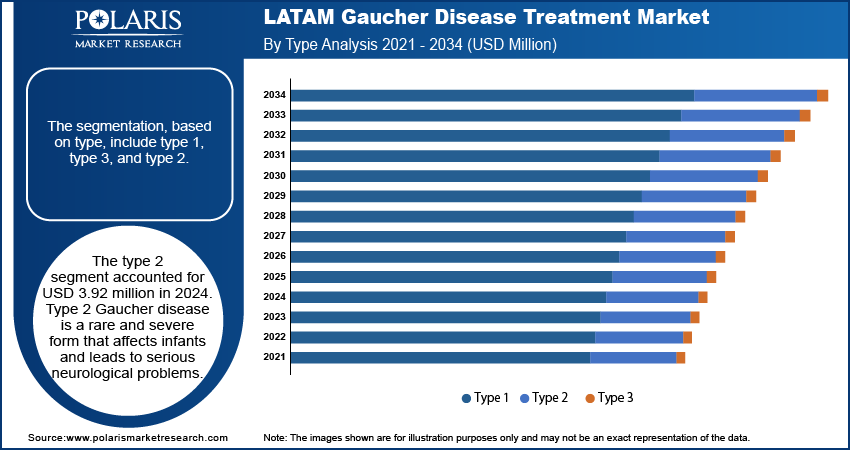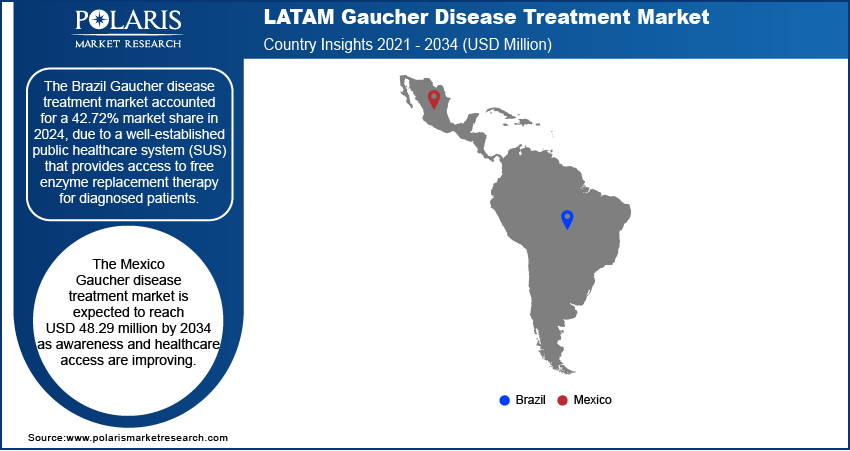
LATAM Gaucher Disease Treatment Market Size, Share, Trends, & Industry Analysis Report
By Type (Type 1, Type 3, and Type 2), By Therapy, By Distribution Channel, By Country – Market Forecast, 2025–2034
- Published Date:Jun-2025
- Pages: 129
- Format: PDF
- Report ID: PM5775
- Base Year: 2024
- Historical Data: 2020-2023
Market Overview
The LATAM Gaucher disease treatment market was valued at USD 184.04 million in 2024 and is expected to register a CAGR of 2.6% during the forecast period. The growth is driven by the rising support from regional academic and research institutions and the entry of international biopharmaceutical companies.
Gaucher disease is a rare genetic disorder that results from a deficiency of the enzyme glucocerebrosidase. This deficiency leads to the accumulation of fatty substances called glucocerebrosides in organs such as the spleen, liver, and bone marrow. A few major symptoms of the disease include enlarged organs, bone pain, anemia, and fatigue. Gaucher disease is inherited in an autosomal recessive pattern. There are several types of the disease, with Type 1 being the most common. Treatment options include enzyme replacement therapy and substrate reduction therapy.

The management of Gaucher disease aims to alleviate symptoms, restore the deficient enzyme glucocerebrosidase, and reduce substrate accumulation. The primary therapeutic approaches include enzyme replacement therapy (ERT), which delivers the active enzyme, and substrate reduction therapy (SRT), which decreases levels of glucocerebroside. Additionally, supportive care plays a crucial role in treatment, addressing the various clinical manifestations associated with the disease.
Latin America's approach to Gaucher disease treatment is evolving, shaped by growing awareness, regional research collaboration, and shifting healthcare priorities. Long-faced with limited recognition of rare genetic disorders, the region is now witnessing improved clinical awareness among healthcare professionals, which is playing a crucial role in identifying Gaucher disease cases earlier and more accurately. Training initiatives and medical conferences supported by international experts are helping clinicians differentiate Gaucher disease from more common hematological or hepatic conditions, which have historically delayed timely diagnosis, thereby driving the growth of the industry.
Industry Dynamics
Rising Support from Regional Academic and Research Institutions
The role of regional academic and research institutions is pushing rare disease agendas as universities and medical centers are increasingly involved in clinical research, epidemiological studies, and registry development related to Gaucher disease. For instance, in January 2025, Brazil co-sponsored the WHO's Rare Diseases Resolution, supporting the Global Action Plan to advance equitable healthcare access and sustainable solutions for rare disease patients, aligning with Universal Health Coverage goals. This academic engagement provides a foundation for evidence-based treatment policies and also strengthens local advocacy and public awareness. Thus, rising support from regional academic and research institutions boosts the industry growth.
Entry of International Biopharmaceutical Companies
Leading biopharmaceutical companies from the US, Europe, and Asia are entering the Latin American market with advanced Gaucher disease treatments. These companies partner with local firms or set up their own operations to distribute therapies more effectively. Their presence ensures a stable supply of high-quality medications and introduces newer therapies that may not have been previously available. These firms also invest in physician education, patient support programs, and local clinical trials and virtual clinical trials. Consequently, patients have more treatment options, and the overall quality of care improves, driving market growth across Latin America.
Regional Volume and Pricing Analysis
|
Manufacturer |
Drug Name |
Dosage (IU/Vial) |
Unit Price per Vial (USD) |
Annual Dose per Patient (Vials/Year) |
Patients (Approx.) |
Total Sales Volume (Vials/Year) |
|
Colombia |
Imiglucerase (Cerezyme), Velaglucerase alfa (VPRIV) |
400 IU |
1,400–1,500 |
26 |
80–220 |
2,080–5,720 |
|
Chile |
xx |
xx |
xx |
xx |
xx |
xx |
|
Peru |
xx |
xx |
xx |
xx |
xx |
xx |
|
Ecuador |
xx |
xx |
xx |
xx |
xx |
xx |
|
Paraguay |
xx |
xx |
xx |
xx |
xx |
xx |
|
Argentina |
xx |
xx |
xx |
xx |
xx |
xx |
|
Mexico |
xx |
xx |
xx |
xx |
xx |
xx |
|
Brazil |
xx |
xx |
xx |
xx |
xx |
xx |
|
Rest of LATAM |
xx |
xx |
xx |
xx |
xx |
xx |
Colombia's enzyme replacement therapy shows significant scale with Imiglucerase/Velaglucerase alfa serving 80-220 patients annually. At 400 IU dosing with 26 vials per patient yearly, the market generates 2,080-5,720 vials annually. Unit pricing ranges USD 1,400-1,500 per vial, indicating a substantial therapeutic market valued in millions.

Segmental Insights
By Type Analysis
The segmentation, based on type, includes type 1, type 3, and type 2. The type 2 segment was valued at USD 3.92 million in 2024. Type 2 Gaucher disease is a rare and severe form that affects infants and leads to serious neurological problems. In Latin America, limited access to early diagnosis and advanced neurological care makes managing Type 2 cases particularly challenging. Since this type progresses rapidly and has no cure, treatment focuses mostly on supportive care rather than long-term therapies such as enzyme replacement. Although the patient pool is small, there is a growing demand for improved palliative care and specialized treatment centers. Efforts by healthcare professionals and advocacy groups are increasing awareness and attention to this highly underserved segment in the market.
The type 3 segment is projected to reach USD 40.65 million by 2034. Type 3 Gaucher disease is a chronic form with both physical and neurological symptoms. It is more common than Type 2 but still considered rare. In Latin America, awareness and diagnosis of Type 3 are slowly improving due to better training of healthcare providers and expanded access to genetic testing. Patients often require lifelong treatment, such as enzyme replacement therapy (ERT), combined with neurological care. The developing healthcare systems across LATAM are improving their rare disease infrastructure, thereby driving the segment growth.
By Therapy Analysis
The segmentation, based on therapy, includes enzyme replacement therapy (ERT), substrate reduction therapy (SRT), and others. The substrate reduction therapy segment accounted for a 26.98% share in 2024. SRT is an oral treatment option for Gaucher disease, offering an alternative to enzyme replacement therapy, especially for patients who cannot tolerate ERT. In Latin America, SRT is gaining traction due to its convenience and growing awareness among healthcare providers. SRT is increasingly being considered, particularly in urban areas with better access to specialist care. Growing regulatory approvals and a shift in patient preference toward oral therapies are further driving the demand, thereby driving the segment growth.
By Distribution Channel Analysis
Based on distribution channel, the segmentation includes hospital pharmacies, retail pharmacies, and online pharmacies. The hospital pharmacies segment accounted for 64.83% share in 2024, as hospital pharmacies are a major distribution channel for Gaucher disease treatments in Latin America. Most therapies, especially enzyme replacement drugs, require administration in clinical settings under medical supervision. Hospital pharmacies ensure proper storage, handling, and administration of these sensitive drugs. Access to life-saving medications is improving as public hospitals and specialized treatment centers expand across the region. These pharmacies often collaborate with government programs or insurance providers to manage the high cost of treatment, thereby driving the growth of the segment.

Country Analysis
Gaucher Disease Treatment Market in Brazil
The Brazil Gaucher disease treatment market accounted for a 42.72% market share in 2024, due to a well-established public healthcare system (SUS) that provides access to free enzyme replacement therapy for diagnosed patients. Several treatment centers and medical universities focus on rare diseases, including Gaucher, which supports early diagnosis and expert care. Brazil further collaborates with international pharmaceutical companies and research networks, improving drug availability and treatment standards. Ongoing government support, combined with a growing number of patient advocacy groups, is driving the growth of the industry in the country.
Gaucher Disease Treatment Market in Mexico
The Mexico Gaucher disease treatment market is expected to reach USD 48.29 million by 2034 as awareness and healthcare access are improving. The country is expanding rare disease policies and integrating specialized treatments into public healthcare schemes. Although treatment access varies between urban and rural areas, major hospitals in cities such as Mexico City and Guadalajara offer enzyme replacement therapy and genetic testing. Private healthcare providers also play a significant role in making therapies available. Support from international pharmaceutical companies and collaborations with nonprofit groups are improving diagnosis rates, thereby driving the industry growth.
Gaucher Disease Treatment Market in Argentina
The Argentina Gaucher disease treatment market held a 13.71% share in 2024, driven by government support and active patient advocacy. The country’s public health system includes rare diseases diagnostics and treatment in its strategic healthcare programs, and patients often receive enzyme replacement therapy at no cost. Medical centers in Buenos Aires and other large cities offer specialized care, and genetic testing is becoming more accessible. Argentina further participates in global research and clinical studies, bringing new treatment options to local patients, thereby driving the growth of the industry.
Gaucher Disease Treatment Market in Colombia
The Colombia Gaucher disease treatment market accounted for a 7.74% share in 2024, driven by improvements in healthcare access and rare disease recognition. The government has included Gaucher disease in its rare disease legislation, supporting diagnosis and subsidize treatment. Urban hospitals in Bogotá and Medellín offer specialized care, while public and private insurers work to improve medication access. Rising public awareness, active patient organizations, and a commitment to universal healthcare are further driving the early diagnostics in Colombia, thereby driving the industry growth in the country.
Gaucher Disease Treatment Market in Chile
The Chile Gaucher disease treatment market accounted for a 5.18% share in 2024, as Chile’s healthcare system has taken steps to address rare diseases such as Gaucher through public policy and targeted health programs. Early diagnosis and access to treatments such as enzyme replacement therapy are improving in major cities. The Chilean government has implemented rare disease registries and provides financial support for high-cost treatments under the Ricarte Soto Law (Law 20.850). Collaborative efforts with international health organizations and local advocacy groups further support education and awareness. Consequently, Chile offers a structured environment for Gaucher disease treatment, thereby driving the industry growth in the country.

Key Players & Competitive Analysis Report
Pharmaceutical companies are increasingly focusing on strategic licensing agreements, collaborative research initiatives, and regional market expansion to improve their competitive positions and diversify their product pipelines. A number of investigational compounds are targeting the central nervous system symptoms of diseases, with a noticeable shift toward the development of small-molecule oral medications that effectively modulate glycosphingolipid biosynthesis.
Current R&D efforts are largely concentrated on therapies designed to reduce the reliance on frequent intravenous infusions while improving treatment accessibility, especially in underrepresented populations. Industry stakeholders are actively seeking regulatory incentives, such as orphan drug designation, to expedite development timelines and secure market exclusivity.
The emergence of biosimilars has intensified competitive dynamics, particularly in healthcare systems where cost considerations are important. Therapeutic strategies are increasingly adopting biomarker-driven approaches and personalized medicine paradigms as the scientific community deepens its understanding of Gaucher disease pathophysiology. This evolving landscape is catalyzing ongoing innovation and escalating competitive pressures across all facets of the LATAM Gaucher disease treatment market.
Key Players
- Amicus Therapeutics, Inc.
- CANbridge Life Sciences Ltd.
- Eli Lilly and Company
- ISU Abxis
- Johnson & Johnson, Inc.
- Lingyi Biotechnology
- Protalix Biotherapeutics Inc.
- Sanofi
- Spur Therapeutics
- Takeda Pharmaceutical
LATAM Gaucher Disease Treatment Industry Developments
January 2025: Brazil co-sponsored the WHA Resolution on Rare Diseases, joining countries such as Chile, Spain, and Egypt. This move strengthened global efforts to promote equity, sustainable care, and Universal Health Coverage for people affected by rare diseases.
December 2024: Theranexus and Exeltis signed a licensing deal to commercialize TX01 for rare neurological diseases such as Gaucher and Niemann-Pick type C diseases, granting Exeltis exclusive rights across Europe and Latin America. The agreement aimed to expand treatment access and included upfront payments and milestone-based royalties.
LATAM Gaucher Disease Treatment Market Segmentation
By Type Outlook (Revenue, USD Million, 2020–2034)
- Type 1
- Type 3
- Type 2
By Therapy Outlook (Revenue, USD Million, 2020–2034)
- Enzyme Replacement Therapy (ERT)
- Substrate Reduction Therapy (SRT)
- Others
By Distribution Channel Outlook (Revenue, USD Million, 2020–2034)
- Hospital Pharmacies
- Retail Pharmacies
- Online Pharmacies
By Country Outlook (Revenue, USD Million, 2020–2034)
- Brazil
- Mexico
- Argentina
- Colombia
- Chile
- Peru
- Ecuador
- Paraguay
- Rest of LATAM
LATAM Gaucher Disease Treatment Market Report Scope
|
Report Attributes |
Details |
|
Market Size in 2024 |
USD 184.04 Million |
|
Market Size in 2025 |
USD 187.83 Million |
|
Revenue Forecast by 2034 |
USD 237.30 Million |
|
CAGR |
2.6% from 2025 to 2034 |
|
Base Year |
2024 |
|
Historical Data |
2020–2023 |
|
Forecast Period |
2025–2034 |
|
Quantitative Units |
Revenue in USD Million and CAGR from 2025 to 2034 |
|
Report Coverage |
Revenue Forecast, Competitive Landscape, Growth Factors, and Industry Trends |
|
Segments Covered |
|
|
Regional Scope |
|
|
Competitive Landscape |
|
|
Report Format |
|
|
Customization |
Report customization as per your requirements with respect to countries, regions, and segmentation. |
FAQ's
The market size was valued at USD 184.04 million in 2024 and is projected to grow to USD 237.30 million by 2034.
The market is projected to register a CAGR of 2.6% during the forecast period.
Brazil dominated the market share in 2024.
A few of the key players in the market are Amicus Therapeutics, Inc.; CANbridge Life Sciences Ltd.; Eli Lilly and Company; Johnson & Johnson, Inc.; Lingyi Biotechnology; Protalix Biotherapeutics Inc.; Sanofi; Spur Therapeutics; Takeda Pharmaceutical; and ISU Abxis.
The type 1 segment dominated the market share in 2024.
The substrate reduction therapy segment is expected to witness the fastest growth during the forecast period.
